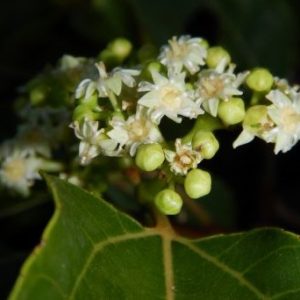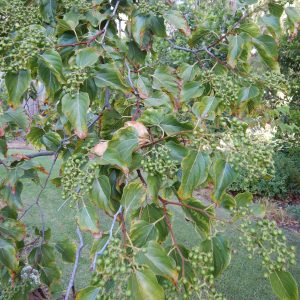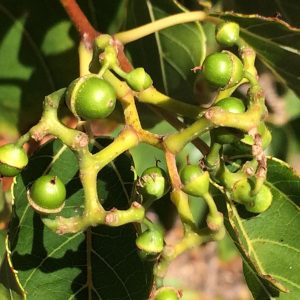Hovenia dulcis
Hovenia, Chinese, Japanese or Oriental raisin rree
Origin
The original centre of distribution was China, Japan and Korea but it’s now grown in regions of India, the US, Cuba, Brazil, North Africa, Southern Europe and elsewhere primarily for its fruit but also as an ornamental. In some environments it can be invasive.
Climate
Moist, cool sub-tropical or temperate humid conditions are preferred although it can tolerate mild drought. In southern China and northern Vietnam and Thailand it grows up to an altitude of 2000m, and is very cold-hardy when in the leafless dormant stage through winter.
Plant Description
The species is deciduous and can grow to 25m with a large high canopy. The spirally- arranged chartaceous and shallowly serrated simple leaves are ovate to oblong 11-13 X 5-9cm with a pointed apex and rounded base, glabrous green on the upper surface and pale green underneath with 3 main pilose veins branching from the 12-14mm long petioles.
Relatives
Member of the Rhamnaceae family containing about 50 genera and 900 species; the genus Hovenia has only 3 species. Jujube (Zizyphus jujuba) is taxonomically close to the raisin tree and really the only other relevant species in the family grown for its fruit. Like the jujube, it also has zig-zagged young branches although in this case less pronounced.
Soils
Non-demanding of soil pH and type, with acceptable growth in acidic and alkaline sands and loams provided they are well-drained and don’t become waterlogged.
Propagation
Usually by seed. Germination is very slow or unreliable but this can be improved with heavy scarification of the thick seed coat. Cuttings represent a better pathway.
Cultivars
There has been no systematic breeding work recorded.
Flowering and Pollination
Inflorescences are terminal or axillary cymes. The greenish-yellow flowers that form in late spring are hermaphrodite and self-fertile, 6-8mm wide, with a glabrous pedicel and sepals, 5 whitish obovate petals with opposing stamens and a globose ovary with a central style dividing into three short terminal lobes. Bees provide at least some of the pollination services.
Cultivation
There has been no systematic breeding work recorded.
Wind Tolerance
Reasonably tolerant when mature.
Pruning
They have a tendency to self-prune lower branches, though if growing in preferred conditions favouring substantial growth you may have to intervene to keep size manageable.
The Fruit
The main edible part is not the fruit itself but the contorted and significantly swollen (tumefied) peduncles and pedicels, 3-7mm diameter, green turning reddish-brown on maturity. They are fleshy with a sweet crunchy pulp that may contain up to 5% tartaric acid (a characteristic acid in grapes and wines) and 25-50% sugars mainly as glucose. If dried, the sugars are concentrated even further. The raisin pear-like taste with overtones of clove and cinnamon plus their dark brown colour gives them their common name. The true drupaceous fruit at the extremity is a 7-8 X 6-7cm dehiscent capsule, green turning brown-black and containing 3 flat orange to brown-black seeds.
Fruit Production and Harvesting
Seedlings may begin flowering in 3-4 years but then another 3-6 years may be necessary before ripe fruit and peduncles are produced; vegetatively-propagated plants may fruit in half this time. Picking the numerous peduncles/pedicels, usually in late summer/autumn, is labour-intensive; this can be done when the true fruit has become dark coloured or when peduncles and fruit fall to the ground.
Fruit Uses
Fruit stalks are usually eaten fresh as a snack food but can also be dried, cooked or otherwise processed; the true fruit is not eaten. The raisin tree is not grown commercially to any extent. The high sugar content makes purees suitable for production of fermented products, and concentrated extracts can be used to make jellies and jams. They do not store well fresh but when dried may keep for several months.
Pests and Diseases
Minimal problems.
Comments
Hovenia dulcis is not a well-known species here or elsewhere and doesn’t produce a top-ranked edible fruit. The small peduncle size is offset by their large number, resulting in a reasonable total harvest but at the expense of picking time. Perhaps its main attributes in WA are novelty value and minimal management issues. The seedling juvenile period is prolonged.


